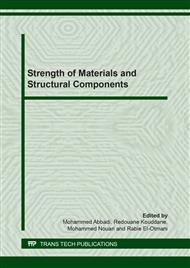p.104
p.118
p.128
p.137
p.147
p.159
p.173
p.179
p.188
The Experimental Prediction of the Lifetime of Acrylonitrile Butadiene Styrene (ABS) by the Energetic Method
Abstract:
In this paper, we are dealing with the study of the mechanical behavior of an amorphous polymer, acrylonitrile butadiene styrene "ABS". In fact, uniaxial tensile tests on rectangular specimens containing a combined defect, with simple and double notches, has been done. The proposed approach develop a method, based on energy parameter, to calculate the evolution of damage over the materials’ life. This method can be used to predict quantitatively the risk of sudden rupture in a structure. Therefore, the damage evaluation based on the residual energy method was compared to the unified theory one for different loading levels. The prediction of damage by experimental models has led to the determination of the three stages of damage evolution, which are the initiation, propagation and complete deterioration of the material. Thus, the concept of reliability is used to specify the critical life fraction, which is similar to the notch depth (βc) of a modeled defect as a combined defect on an ABS sample. In addition, the unified theory was used in this work, to define on the one hand, the parameter of damage which is the internal variable which describes the failure level of the structure in function of life fraction, on the other hand, for the theoretical evaluation of the level of damage. Finally, we have proved that the theoretical and experimental results show a good agreement.
Info:
Periodical:
Pages:
147-158
Citation:
Online since:
September 2019
Keywords:
Price:
Сopyright:
© 2019 Trans Tech Publications Ltd. All Rights Reserved
Share:
Citation:


